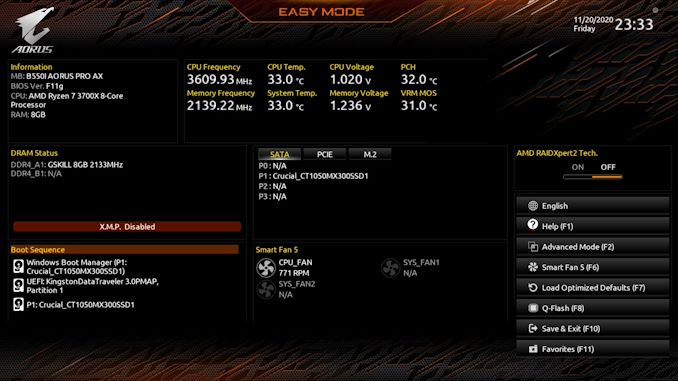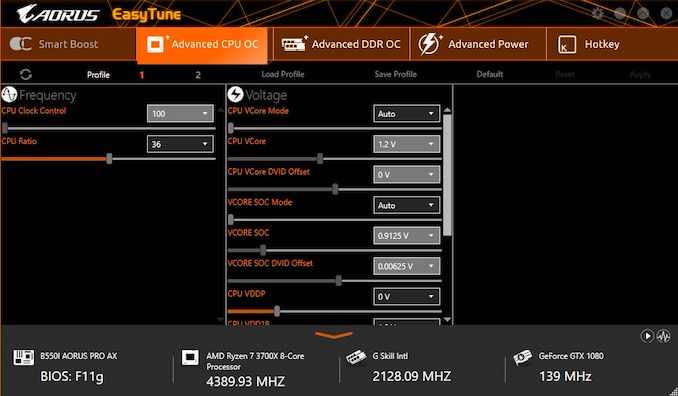The GIGABYTE B550I Aorus Pro AX Motherboard Review: All The Small Things
by Gavin Bonshor on December 7, 2020 10:00 AM ESTBIOS
Unspringsingly, GIGABYTE's B550 firmware is practically identical to its X570 models, as we've seen previously in our GIGABYTE X570 I Aorus Pro WIFI review. The GIGABYTE UEFI firmware for its AMD 500 series Aorus branded models follows a distinct black and orange theme, with white text and orange highlighting. Looking at the BIOS layout, GIGABYTE has split the firmware into two modes, easy mode for the beginner and advanced for the more experienced user.
Focusing on the Easy mode screen, which is the default screen when POSTing for the first time, displays basic yet relevant information about hardware installed. Towards the top is a list of information, including the motherboard model, the BIOS version (F11g for our test), and the processor and amount of memory installed. Users can select between the different types of devices to check if the hardware is installed correctly, including SATA, PCIe, and M.2 devices, as well as a basic list of Smart 5 fan details for the board's three 4-pin fan headers. Along the right-hand side, users can select between different functions, including the advanced mode by pressing the F2 key, load up the Smart Fan 5 tuning utility by pressing F6, and the board's integrated Q-Flash utility for updating the board's firmware by pressing the F8 key.
The rest of the board's firmware focuses on the Advanced mode, which can be done by pressing the F2 key. This allows users to select between various BIOS functions, including the Tweaker sections where all of the board's CPU, memory, and integrated graphics overclocking can be done. Users can adjust CPU frequency, the base clock (BCLK), CPU VCore, among many other voltage settings, including CPU VDDP and DRAM termination voltages. This is also where users can enable XMP profiles at the click of a button or customize memory profiles further for performance tweakers. It should be noted the sweet spot for Ryzen 3000 processors is DDR4-3600, with an Infinity Fabric clock speed of 1800 MHz.
Overall, GIGABYTE's Aorus UEFI firmware keeps things simple with the basic mode, with a basic looking, but the bountiful and endless list of configurable variables, most of which can be found in the Tweaker section. The firmware itself is responsive and offers users from both the novice and advanced spectrums plenty of options to work with.
Software
All of the major motherboard vendors have equally impressive software packages, with various functions to use all of the boards primarily features. GIGABYTE includes plenty with the B550I Aorus Pro AX model, including the EasyTune software designed to allow users to overclock within Windows, the RGB Fusion 2.0 software to control the board's RGB capabilities, and the System Information Viewer (SIV). The SIV software allows users to access the Smart Fan 5 utility within Windows and allows for system alerts for over-voltage and various temperatures.
The most prominent piece of software bundled with the GIGABYTE is the Aorus Easy Tune software. This allows users to overclock the memory and CPU within Windows, with plenty of voltage options and important CPU ratio and memory ratio settings. We still recommend all of the overclocking is done within the BIOS, but overclocking software has come a long way over the last decade, and Easy Tune is quite intuitive.
Unfortunately, GIGABYTE doesn't include any audio software within the bundle, and users looking to make customizations will need to download the Realtek Control Panel directly from the Microsoft Store. Focusing on what is actually there, the bundle offers plenty of customizability. This includes the Fusion 2.0 RGB software for those adding additional RGB LED strips and the Realtek Gaming LAN manager for traffic shaping when used with the RTL8125 2.5 GbE port on the rear panel. It's not the most comprehensive software suite we've seen over the years, but it's more than enough for a sub $200 model aiming at the mid-range.
























76 Comments
View All Comments
Gigaplex - Wednesday, December 9, 2020 - link
I'm not sure how that would be a B550 issue, as the Bluetooth module is an add-in card.Questor - Wednesday, December 9, 2020 - link
"The end decision could come down to performance, memory compatibility, and other aspects such as power delivery, rear panel I/O connectivity, which all three models include respectable offerings..."Not so much. There is only so much one can expect (as the article states) with mini-ITX boards. The one thing they had to do? A USB C front panel header. They failed. H
Had this board in cart and was about to hit the, "send it to me yesterday" button when something made me pause. A quick doublecheck and sure enough, no front panel USB C connection. Less bling and more substance please. Fan headers and accessory connections = good. Flashing lights = police stop. No thanks.
jeremyshaw - Wednesday, December 9, 2020 - link
Yeah, every B550 ITX board has one problem or another. MSI has their custom backplate. ASRock has never heard of SPDIF and are allergic to including enough USB ports on their AMD boards. ASUS has serious hate for USB ports (4 USB-A!?) along with nixing the SPDIF port. Gigabyte still pretends USB-C headers are an exclusive Intel feature.Most of these problems magically disappear when these vendors make Intel ITX boards.
Questor - Thursday, December 10, 2020 - link
Amazing how that just magically happens.I was reminded by another here there are USB A to C connectors one can buy. So that is less of a deal breaker to me now. It still depends on the position of the USB A connection since it was not purposely placed as a front connection. Cable length matters.
mkarwin - Tuesday, December 15, 2020 - link
Or when they do AMD ATX ones ;)Silver5urfer - Thursday, December 10, 2020 - link
AT even 6900XT Is out Where are your Architecture reviews ? FFS. We got that stupid M1 BGA trash review deep dive and saying x86 is fucking dead. But where are the reviews of the Nvidia and AMD graphics cards this time AMD got Nvidia in Raster technology but we need the technical details.Really horrible.
Gigaplex - Thursday, December 10, 2020 - link
Calling the M1 "trash" is flat out fanboy bias. It's an interesting chip and performs well. AnandTech covers all areas of tech, not just gaming on Windows.Silver5urfer - Thursday, December 10, 2020 - link
BGA Trash son. Its called BGA trash for a reason, if you love soldered HW enjoy that irreparable garbage, and forget even upgrading RAM, SSD, everything soldered and gated by "custom blackbox security chip". M1 is first product on the translation and ARM based Mac it is garbage and will be garbage, so unless they can catch up and beat Intel and AMD at SMT it's of no use.AT HW is majority for Linux and Windows. Macs ? Do AT review macbooks ? Nope. This is their first. Because of that obsession of showing Apple in glowing light.
10% marketshare product is Mac OS, same sales value for Apple as well, so yeah trash.
Gigaplex - Thursday, December 10, 2020 - link
Pretty much every single Intel laptop is soldered on, too. The M1 architecture doesn't mandate BGA soldering. It's the portable form factor that does. You can't call the architecture garbage just because of a form factor you're not interested in.And yes, AT does feature Apple products. There's plenty of Macbook articles and reviews. Now you're just being ignorant. There's a whole section for Apple.
https://www.anandtech.com/tag/apple
Avalon - Friday, December 11, 2020 - link
I've got the non-ITX version of this board, and it's fantastic.